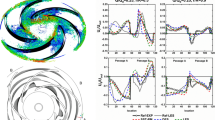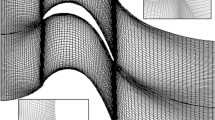Abstract
Current research on pump-turbine units is focused on the unstable operation at off-design conditions, with the characteristic curves in generating mode being S-shaped. Unlike in the traditional water turbines, pump-turbine operation along the S-shaped curve can lead to difficulties during load rejection with unusual increases in the water pressure, which leads to machine vibrations. This paper describes both model tests and numerical simulations. A reduced scale model of a low specific speed pump-turbine was used for the performance tests, with comparisons to computational fluid dynamics(CFD) results. Predictions using the detached eddy simulation(DES) turbulence model, which is a combined Reynolds averaged Naviers-Stokes(RANS) and large eddy simulation(LES) model, are compared with the two-equation turbulence mode results. The external characteristics as well as the internal flow are for various guide vane openings to understand the unsteady flow along the so called S characteristics of a pump-turbine. Comparison of the experimental data with the CFD results for various conditions and times shows that DES model gives better agreement with experimental data than the two-equation turbulence model. For low flow conditions, the centrifugal forces and the large incident angle create large vortices between the guide vanes and the runner inlet in the runner passage, which is the main factor leading to the S-shaped characteristics. The turbulence model used here gives more accurate simulations of the internal flow characteristics of the pump-turbine and a more detailed force analysis which shows the mechanisms controlling of the S characteristics.
Similar content being viewed by others
References
MEI Zuyan. Pumped storage technology[M]. Beijing: Tsinghua University Press, 1986. (in Chinese)
TANAKA H, TSUNODA S. The development of high head single stage pump-turbines[C]//Proceedings of 10th IAHR Symposium on Hydraulic Machinery and Cavitation, Tokyo, Japan, 1980: 429–440.
HASMATUCHI V, ROTH S, BOTERO F, et al. High-speed flow visualization in a pump-turbine under off-design operating conditions[C]//IOP Conference Series: Earth and Environmental Science, IOP Publishing, 2010, 12(1): 012059.
HASMATUCHI V, FARHAT M, ROTH S, et al. Experimental evidence of rotating stall in a pump-turbine at off-design conditions in generating mode[J]. Journal of Fluids Engineering, 2011, 133(5): 051104.
WILDMER C, STAUBLI T, LEDERGERBER N. Unstable characteristic and rotating stall in turbine brake operation of pump-turbines[J]. Journal of Fluids Engineering-Transactions of the ASME, 2011, 133(1): 041101.
XIAO Ruofu, SUN Hui, LIU Weichao, et al. The analysis of S characteristics and its pressure pulsation of pump-turbine under Pre-opening guide vanes[J]. Journal of Mechanical Engineering, 2012, 48(8): 174–179. (in Chinese)
SUN Hui, XIAO Ruofu, LIU Weichao, et al. Analysis of S characteristics and pressure pulsations in a pump-turbine with misaligned guide vanes[J]. Journal of Fluids Engineering-Transactions of the ASME, 2013, 135(5): 051101.
SPALART P R. Strategies for turbulence modeling and simulations[J]. International Journal of Heat Fluid Flow, 2000, 21(3): 252–263.
SPALART P R. Young person’s guide to detached-eddy simulation grids[G]. Technical Report CR-2001-211032, NASS.
CONSTANTINESCU S G, SQUIRES K D. LES and DES investigations of turbulent flow over a sphere[M]. American Institute of Aeronautics and Astronautics, 2000.
LI Guojing, DAI Guangqing, YANG Qing, et al. Detached eddy simulation of hydraulic characteristics along the side-wall after a new arrangement-scheme of the sudden lateral enlargement and the vertical drop[J]. Journal of Hydrodynamics, 2011, 23(5): 669–675.
MOHAMMAD F A, KEITH D, DAVID S T. A new hybrid RANS/LES modeling methodology for CFD applications[C/CD]// Proceeding of the ASME-JSME-KSME Joint Fluids Engineering Conference, Hamamatsu, Japan, July 24–29, 2011.
MENTER F R, KUNTZ M, BENDER R. A scale-adaptive simulation mode using two-equation models[G]. AIAA Paper 2003-0767.
FORSYTHE J R, HOFFMANN K A, CUMMINGS R M, et al. Detached-eddy simulation with compressibility corrections applied to a supersonic axisymmetric base flow[J]. Journal of Fluids Engineering, 2002, 124: 911–923.
SHUR M L, SPALART P R, STRELETS M K, et al. A hybrid RANS-LES approach with delayed-DES and wall-modelled LES capabilities[J]. International Journal of Heat and Fluid Flow, 2008, 29(6): 1638–1649.
SLIMON S. Computation of internal separated flows using a zonal detached eddy simulation approach[C/CD]//Proceedings of the 2003 ASME International Mechanical Engineering Congress, Washington, DC, USA, 2003.
DAVIDSON L, BILLSON M. Hybrid LES-RANS using synthesized turbulent fluctuations for forcing in the interface region[J]. International Journal of Heat and Fluid Flow, 2006, 27(6): 1028–1042.
MISRA A, PULLIN D I. A vortex-based subgrid stress model for large-eddy simulation[J]. American Institute of Physics, 1997, 9(8): 2444–2454.
STRELETS M. Detached eddy simulation of massively separated flows[G]. AIAA Paper, 2001-0897.
BERTEN S. Hydrodynamics of high specific power pumps for off-design operating conditions[D]. Lausanne, Switzerland: EPFL, 2010.
MEI Zuyan. Pumped storage power generation technology[M]. Beijing: Mechanical Industry Press, 2000. (in Chinese)
Author information
Authors and Affiliations
Corresponding author
Additional information
Supported by National Natural Science Foundation of China (Grant No. 51139007), and State Key Laboratory of Hydroscience and Engineering Open Foundation of China (Grant No. 2014-KY-05)
SUN Hui, born in 1988, is currently a master candidate at College of Water Resources and Civil Engineering, China Agricultural University, China.
XIAO Ruofu, born in 1976, is currently an associate professor and a PhD candidate supervisor at College of Water Resources and Civil Engineering, China Agricultural University, China. He received his PhD degree from Huazhong University of Science and Technology, China, in 2004. His research interests include hydraulic machinery and Fluid-structure interaction.
WANG Fujun, born in 1964, is currently a professor and a PhD candidate supervisor at College of Water Resources and Civil Engineering, China Agricultural University, China.
XIAO Yexiang, born in 1978, is currently an associate professor at State Key Laboratory of Hydroscience and Engineering & Department of Thermal Engineering, Tsinghua University, China.
LIU Weichao, born in 1973, is currently an engineer at Dongfang Electric Machinery Co., Ltd, China.
Rights and permissions
About this article
Cite this article
Sun, H., Xiao, R., Wang, F. et al. Analysis of the pump-turbine S characteristics using the detached eddy simulation method. Chin. J. Mech. Eng. 28, 115–122 (2015). https://doi.org/10.3901/CJME.2014.1021.159
Received:
Revised:
Accepted:
Published:
Issue Date:
DOI: https://doi.org/10.3901/CJME.2014.1021.159




